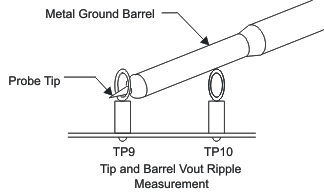SLVU192B February 2007 – January 2022 TPS40077
- Trademarks
- 1Introduction
- 2TPS40077EVM-001 Electrical Performance Specifications
- 3Schematic
- 4TPS40077EVM Typical Performance Data and Characteristic Curves
- 5EVM Assembly Drawings and Layout
- 6List of Materials
- 7Revision History
3.3.1.4 Oscilloscope
A digital or analog oscilloscope can be used to measure the ripple voltage on VOUT. The oscilloscope should be set to the following to measure output ripple:
- 1-MΩ impedance
- 20-MHz bandwidth
- AC coupling
- 1-μs/division horizontal resolution
- 20-mV/division vertical resolution
TP9 and TP10 can be used to measure the output ripple voltage by placing the oscilloscope probe tip through TP9 and holding the ground barrel to TP10 as shown in Figure 3-2. For a hands-free approach, the loop in TP10 can be cut and opened to cradle the probe barrel. Using a leaded ground connection must be avoided because it induces additional noise due to its large ground-loop area.
 Figure 3-2 Output Ripple Measurement – Tip and Barrel Using TP9 and TP10
Figure 3-2 Output Ripple Measurement – Tip and Barrel Using TP9 and TP10